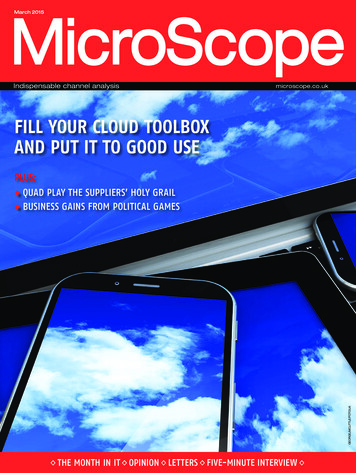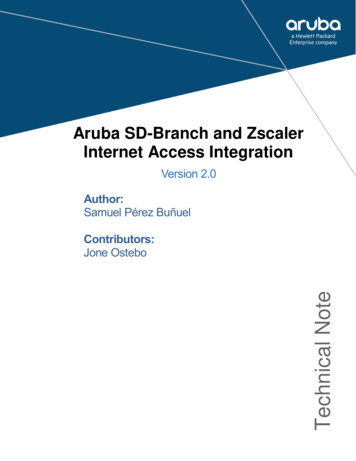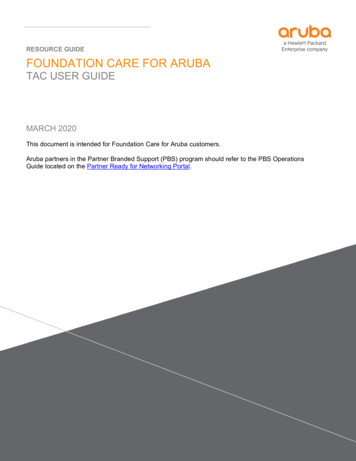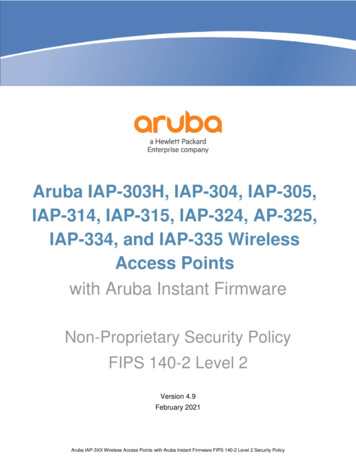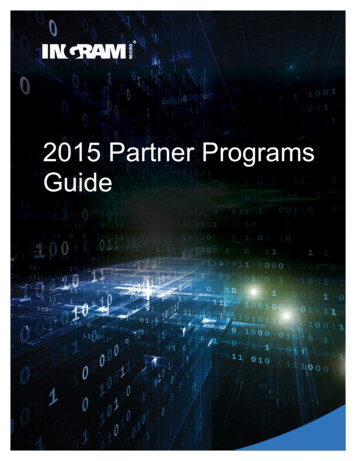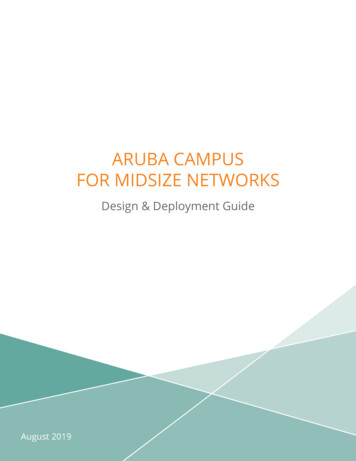
Transcription
ARUBA CAMPUSFOR MIDSIZE NETWORKSDesign & Deployment GuideAugust 2019
Table of ContentsDocument Conventions.1Introduction.2Purpose of This Guide.2Customer Use Cases.3Aruba Campus Design.5Campus Wireless LAN Design Using Aruba Instant.6Instant Design Components. 19Campus Wired LAN Design. 22Wired Design Components. 31Deploying the Aruba Campus.35Campus Wired LAN. 36Configuring the Access Switch. 37Configuring the ArubaOS-Switch Aggregation Switch. 52Configuring the ArubaOS-CX Aggregation Switch. 65Campus Wireless LAN. 75Configuring the Instant Access Point Virtual Controller. 75Summary.98Validated Hardware and Software.99What’s New in This Version.100Aruba Design & Deployment Guide
Document ConventionsBold text indicates a command, navigational path, or a user interface element. Examples: the show stacking command Navigate to Configuration System General click SaveItalic text indicates the definition of important terminology. Example: Spatial streaming is a transmission technique in MIMO wireless communicationBlue text indicates a variable for which you should substitute a value appropriate for your environment.Example: stacking member 2 priority 250Highlighting indicates emphasis. Example: ip address 10.4.20.2/22Note Notes contain asides or tips.Caution Cautions warn you about circumstances that could cause a failure.Aruba Design & Deployment Guide1
IntroductionWireless has become the primary network access method for today’s evolving mobile environments. In thepast, wireless networks were a “nice to have,” but they have evolved into a mission-critical lane for connectivity and play a major role in business continuity and in customer and employee satisfaction. In recent years,the number of connected devices per user has increased to more than three, and some estimate it will rise toas many as five per user in the next few years. Employees have their company-supplied PCs, their personaltablets, company-supplied or personal smart phones, and even their smart watches connected to the corporate Wi-Fi network. Users move between locations with their devices and require always-on access. Whenvisiting your employees on-site, guests expect to have access to the Internet from their wireless devices. TheAruba campus network is designed to allow people to move while connected, securely separate employeetraffic from guest traffic and to allow enterprises to innovate without being tied to a wired infrastructure. Itcombines the best wireless products, a wired infrastructure ready to support mobility and Internet of Things(IoT) devices, as well as end-to-end network management with multi-vendor access control.Because most people work from both company-supplied and personal devices, wireless network accessmust become ubiquitous to accommodate the new mobile workplace. Guests want Internet access fromtheir personal computers, tablets and smart phones, a desire that becomes a major challenge for IT departments due to the lack of control over the devices. In addition, many IoT devices connect wirelessly to today’snetworks. IoT devices such as building control systems, card readers, thermostats, and surveillance camerasdo not have users associated with them. Their traffic is considered machine-to-machine and the devicesrequire machine authentication, which differs from user authentication. Even devices that have traditionallyused wired connections, such as shared printers, copy machines, multimedia devices, and high-end workstations, are moving to the wireless world. A network with a few hundred users can easily have over a thousandconnected devices.PURPOSE OF THIS GUIDEThis guide covers the Aruba Campus design, including reference designs along with their associated hardwareand software components. It contains an explanation of the requirements that shaped the design andthe benefits it will provide your organization. The guide describes the access layer as a single system thatintegrates access points (APs), access switches, aggregation switches, and network management with accesscontrol and traffic-control policies.Design GoalsThe overall goal is to create a simple scalable design that is easy to replicate at different sites in your network.The components are limited to a specific set of products to help with operations and maintenance. The designhas a target of sub-second failover when a network device or link between two network devices becomesunavailable. The protocols are tuned for a highly-available network in all functional areas. The design deployslink aggregation and multi-chassis link aggregation between aggregation and access devices. Routed links areutilized at the Core with layer-3 path redundancy.Aruba Design & Deployment Guide2
You can use this guide to design new networks or to optimize and upgrade existing networks. It is notintended as an exhaustive discussion of all options, but rather to present the most commonly recommendeddesigns, features, and hardware.AudienceThis guide is written for IT professionals who need to design an Aruba wired-and-wireless network for amidsize organization with up to 500 users. These IT professionals can fill a variety of roles: Systems engineers who need a standard set of procedures for implementing solutions Project managers who create statements of work for Aruba implementations Aruba partners who sell technology or create implementation documentationCUSTOMER USE CASESWith so many wireless devices on a network, performance and availability are key. Wireless clients with different capabilities support different performance levels. If the wireless network doesn’t self-optimize, slowerclients can degrade performance for faster clients. Clients need to intelligently connect to radios on APs toincrease network efficiency and performance.802.11ac Wave 2 Wi-Fi supports speeds greater than 1 Gbps. To accommodate the increased data rates, theAPs support 2.5 and 5 Gbps over standards-based, unshielded twisted-pair copper, which works on existingbuilding cabling using Aruba access switches. The access layer acts as a collection point for high-speed wireless devices and must have enough performance to support the bandwidth needs of today as well as scale forthe future as the number of connected devices growSecurity is also a critical part of the campus network. Users must be authenticated and given access to theservices they need to do their jobs. IoT devices must be identified using machine authentication to preventrouge devices from using the network. In addition to corporate-managed assets, users connect personaldevices, guests need access to the Internet, and contractors need access to the Internet and the organization’sinternal network. This type of broad access must be accomplished while maintaining the security and integrityof the network. Connecting so many devices and user types increases the administrative burden, and thenetwork should allow you to automate device onboarding in a secure manner.Before wireless became the primary network access method, typical network designs provided two or morewired ports per user. It was common to run two network drops to each user’s desk and then have additionalports for conference rooms, network printers, and other shared areas, adding up to just over two ports peruser. With the trend of users moving to wireless as the primary method of network access, the average wiredports per person is dropping. This trend will continue as more devices move to wireless for connectivity to thenetwork.Aruba Design & Deployment Guide3
This guide will discuss the following use cases: Wireless as the primary access method for employees Wireless guest access for customers, partners, and vendors Switch stacking for simplified management, high availability, and scalability Link aggregation for high bandwidth, redundancy, and resiliency between switches IP multicast to efficiently propagate streaming traffic across the networkAruba Design & Deployment Guide4
Aruba Campus DesignThis design is targeted for midsized organizations supporting up to 500 users with multiple devices peruser. The network could be a single building, a few floors in a larger building, or a group of small buildingslocated near each other. The wireless network requires a common wired local area network (LAN) designwhich consists of two or three tiers. The access layer is where wired devices and wireless APs connect to thenetwork. The aggregation layer acts as a connection point for multiple access-layer switches. Optionally, thecore layer is used to interconnect aggregation-layer switches from multiple buildings or multiple floors in abuilding. For a network of up to 500 users, a two-layer campus design is the most common as shown in thefollowing figure.Figure 1Two-tier campus tsThe access-layer switches and switch stacks connect to the dual-switch aggregation using multi-chassis linkaggregation (MC-LAG) for higher bandwidth and resiliency.Aruba Design & Deployment Guide5
The three-tier design is used when there are several buildings in a campus that need to be connected andnumber of aggregation switches or the layout of the physical wiring plant makes more sense to connecteverything to a central core. The three-tier campus design is shown in the following figure.Figure 2Three-tier campus ayer-2(Switching)The Aruba Campus design uses access switches or switch stacks connected to a dual-switch aggregation layer.In networks where 80% or more of the users are connecting via wireless, the number of wired ports in thenetwork is getting close to one per user. This design minimizes the number of different components in orderto make operations, maintenance, and troubleshooting simpler.In this design, Aruba Instant Access APs are used for wireless access because they are simple to deploy andmaintain in a network of this size. Both modular and stackable access switches are available, depending onthe number of ports needed in the wiring closets. In smaller closets, stackable switches are more cost effective, but at a certain port density, modular access switches will be less expensive than a stack of fixed accessswitches.CAMPUS WIRELESS LAN DESIGN USING ARUBA INSTANTThe Aruba campus wireless LAN (WLAN) provides network access for employees, wireless Internet access forguests, and connectivity for IoT devices. Regardless of their location on the network, wireless devices have thesame experience when connecting to their services.Aruba Design & Deployment Guide6
The benefits of the Aruba Edge wireless campus: Location-independent network access improves employee productivity. Hard-to-wire locations receive network connectivity without costly construction. Wireless is plug-and-play, and wired LAN switches automatically recognize and provision AP ports. Centralized control of wireless environment allows easy management and operation. Reliable wireless connectivity, including complete radio frequency (RF) spectrum management, isavailable with key Aruba management features.Wireless networks today are engineered based on user capacity needs rather than basic wireless coverage.High-speed, high-quality wireless everywhere in the organization is required for today’s mobile-first environments. Each client should be able to connect to multiple APs from anywhere in the network. This enables lowlatency roaming for real-time applications and allows the network to adapt during routine AP maintenance oran unscheduled outage. A higher density of APs allows the network to support more wireless devices whiledelivering better connection reliability.Aruba InstantFor today’s wireless networks, they are two main deployment models: one where APs connect to dedicatedcontrollers and one that is controllerless. Aruba Instant is a controllerless wireless architecture that is easy toset up and that supports robust security features. It includes automatic RF management to ensure the bestWi-Fi connection and granular visibility into applications, which helps prioritize business-critical data, limit orblock non-business data, and keep malicious actors off your network. A controllerless design is well suited forsmaller deployments where tunneling traffic is not needed because of the size of the network and other moreadvanced controller-based features are not needed. Unlike other autonomous APs, which require a separatemanagement system, an Aruba Instant cluster distributes certain functions across the APs in the cluster andelects a single AP to act as a virtual controller for the remaining management and configuration functions.An Aruba Instant network can be managed with the built-in administrative GUI, with Aruba AirWave, or withAruba Central, a cloud-based management platform.Access Point PlacementAruba recommends doing a site survey for all wireless network installations. The main goal of a site survey isto determine the feasibility of building a wireless network on your site. You also use the site survey to determine the best place for access points and other equipment, such as antennas and cables. With that in mind,you can use the following guidelines as a good starting point for most typical office environments.For typical wireless bandwidth capacity in an office environment, we recommend placing APs approximatelyevery 35-50 feet (10-15 meters). Each AP provides coverage for 1500-2500 square feet (140-232 squareAruba Design & Deployment Guide7
meters) with enough overlap for seamless client roaming. In traditional offices, the average space per useris approximately 175-200 square feet (16-18.5 square meters), and in open-office environments, the spaceper user can be as low as 75-100 square feet (7-9.3 square meters). With three devices per user, a traditionaloffice layout with 50-foot AP spacing and approximately ten users per 2000 square feet leads to an average of30 devices are connected to each AP.The numbers work out roughly the same in higher-density, open-office layouts with 35-foot AP spacing.Because users move around and are not evenly distributed, the higher density allows the network to handlespikes in device count and growth in the number of wireless devices over time. In an average 500-usernetwork with three devices per person, this works out to 1500 total devices, and with 30 devices per AP, thistranslates to 50 APs. While Aruba Instant can scale well past 50 APs in a single cluster, we are comfortablewith an organization building clusters up to 50 APs using standard Instant features. If your design goes past50 APs per cluster, please involve a skilled wireless partner or Aruba SE/CSE for verification of the solution.Whenever possible, APs should be placed near users and devices in offices, meeting rooms, and commonareas, instead of in hallways or closets. The following figure shows a sample office-floor layout with APs.The staggered spacing between APs is equal in all directions and ensures suitable coverage and seamlessroaming.Figure 3Sample office AP layout (not to scale)After studying your environment with the 35-50-foot (10-15 meter) rule in mind, make sure you also haveenough capacity for the number of users. In an average office environment with APs every 35-50 feet (10-15meters), the 30 devices per AP average will easily be satisfied. However, if you have high-density areas such aslarge conference rooms, cafeterias, or auditoriums, additional APs may be needed.Aruba Design & Deployment Guide8
Channel PlanningThe Aruba Adaptive Radio Management (ARM) software is very good at automating channel assignment,and for most wireless installations, channel selection and transmit power can be left to its sophisticatedalgorithms. If you want to plan your channels on your own following the details in this section, please contactan Aruba or partner systems engineer or consulting systems engineer (SE/CSE) for verification of your design.The following figure shows a typical 2.4-GHz channel layout with each color representing one of the threeavailable non-overlapping channels of 1, 6, and 11 in this band. Reused channels are separated as much aspossible, but with only three available channels there will be some co-channel interference which is causedby two radios on the same channel. We recommend only using these three channels for your 2.4-GHz installations to avoid the more serious problem of adjacent channel interference which is caused by radios onoverlapping channels or adjacent channels with radios too close together. A professional site survey couldfurther optimize this type of design with a custom power level, channel selection, and enabling and disabling2.4 GHz radios for optimal coverage and to minimize interference.Figure 4Channel layout for 2.4-GHz band with three unique channelsThe 5-GHz band offers higher performance and suffers from less external interference than the 2.4-GHz band.It also has many more channels available so it is easier to avoid co-channel interference and adjacent channelinterference. Because of the channel advantages, we recommend all capable clients connect on 5 GHz and werecommend converting older clients from 2.4 GHz to 5 GHz when possible. As with the 2.4-GHz spectrum, theradio management software handles the automatic channel selection for the 5-GHz spectrum.Channel WidthAn important decision for 5-GHz deployments is what channel width to use. Wider channel widths meanhigher throughput for individual clients but fewer non-overlapping channels, while narrower channel widthsresults in less available bandwidth per client but more available channels.Aruba Design & Deployment Guide9
In most office environments, 40-MHz-wide channels are recommended because they provide a good balanceof performance and available channels. If you are in a high-density open-office environment or you know youwill lose channels due to DFS interference, you should consider starting with 20-MHz channels.However, due to the high number of APs and increasing number of connected devices, there are almostno office environments that would benefit from 80-MHz-wide channels, let alone the much wider 160-MHzchannels. The following figure highlights the 40-MHz channel allocation for the 5-GHz band.CHANNEL WIDTH20 MHzUNII-2-ExtendedDFS ChannelsUNII-3ISM165WI-FI CHANNEL #UNII-23640444852566064UNII-1149153157161802.11ac channel allocation for the 5-GHz band100104108112116120124128132136140144Figure 580 MHz160 MHz1022A40 MHzDepending on country-specific or region-specific restrictions, some of the UNII-2/UNII-2 Extended DynamicFrequency Selection (DFS) channels may not be available. In the past, it was common to disable DFS channels, but today most organizations attempt to use all channels available in their country. In some areas DFSchannels overlap with radar systems. If an AP detects radar transmissions on a channel, the AP will stoptransmitting on that channel for a time and move to another channel. If specific DFS channels regularly detectradar in your environment, we recommend removing those channels from your valid-channel plan to preventcoverage problems.Using the recommended 40-MHz-wide channels, there are up to 12 channels available. Depending on localregulations and interference from radar or other outside sources, the total number of usable channels willvary from location to location.You can find a list of the 5-GHz channels available in different countries at the following link:https://en.wikipedia.org/wiki/List of WLAN channels#5 GHz (802.11a/h/j/n/ac/ax)Spatial StreamsSpatial streaming is a transmission technique in multiple-input and multiple-output (MIMO) wireless communication that allows clients to transmit multiple steams on multiple antennas. The theoretical bandwidthdepends on the number of spatial steams and channel width. The following table shows the maximumtheoretical bandwidth for the different channel widths and number of available spatial streams.Aruba Design & Deployment Guide10
Table 1Theoretical bandwidth for 802.11ac at various channels widths and spatial stream countsChannelswidthsMax availablechannels1 spatial streams(1SS)2 spatial streams(2SS)3 Spatial streams(3SS)4 spatial streams(4SS)20 MHz2587 Mbps173 Mbps289 Mbps347 Mbps40 MHz12200 Mbps400 Mbps600 Mbps800 Mbps80 MHz6433 Mbps867 Mbps1.3 Gbps1.73 Gbps160 MHz2867 Mbps1.73 Gbps2.6 Gbps3.46 GbpsBoth the client and the AP need to support the same number of spatial steams to maximize the advantages ofthis technology. In general, low-power clients like smart phones and low-cost tablets support a lower numberof spatial steams and high-power tablets and laptops support a larger number of spatial streams. ArubaClientMatch balances clients by capability across APs in the network, in order to maximize the service levelsavailable to each type of client.Site SurveyA site survey is an important tool that gives you a solid understanding of the radio frequency behavior at yoursite and, more importantly, where and how much interference you might encounter with your intendedcoverage zones. A site survey also helps you to determine what type of network equipment you need, whereit goes, and how it needs to be installed. A good survey allows identification of AP mounting locations, existing cable plants, and yields a plan to get the wireless coverage your network requires. RF interacts with thephysical world around it, and because all office environments are unique, each wireless network has slightlydifferent characteristics. The recommendations listed in the section above are a good starting point, but asolid site survey allows you to customize the RF plan for your specific location.If you want to provide ubiquitous multimedia coverage with uninterrupted service, you need a professionalsite survey to balance the elements required for success. Planning tools have evolved with the radio technologies and applications in use today, but a familiarity with the RF design elements and mobile applications isrequired in order to produce a good plan. Completing a site survey before you deploy yields information thatcan be used again and again as the wireless network grows and continues to evolve.802.11ax (Wi-Fi 6) EnhancementsThe most significant new feature of the 802.11ax standard is orthogonal frequency-division multiple access(OFDMA), which replaces orthogonal frequency-division multiplexing (OFDM). Other important new featuresinclude BSS coloring and the ability to transmit up to 8 clients with Multi-User Multiple Input Multiple Output(MU-MIMO).Aruba Design & Deployment Guide11
OFDMAWith OFDM, frames are transmitted consecutively using the entire channel to a single client at a time. Forexample, if a client is connected to a 20 MHz wide channel and sends data, the entire channel is taken up, andthen the AP and clients take turns, one at a time, sending data on the channel.OFDMA changes that behavior. You can divide the channel into smaller sub-channels, and the AP can senddata to multiple clients at a time. A 20 MHz wide channel can support up to nine clients, and you can adjustthe number of sub-channels in order to support fewer higher-speed clients or more lower-speed clients.Sub-channel use is dynamic, and you can adjust it every transmission cycle, depending on client data needs.Figure 6OFDMA operation in 802.11ax—multiple clients share the channelClient 620 MHzFrequencyChannel WidthClient 5Client 4Client 3Client 2Time1075AClient 1Wider channels can support even more sub-channels. An 80-MHz-wide channel can support up to 37 clients ata time. OFDMA supports downlink traffic, from the AP to the clients, and will eventually support uplink traffic,from the clients to the AP.Aruba Design & Deployment Guide12
8X MU-MIMOThe 802.11ax standard enhances MU-MIMO and will support up to eight clients at a time (the 802.11acstandard allowed for eight, but vendors only implemented four or less). This feature effectively doubles thenumber of devices to which an AP can talk.Figure 78x8:8 MU-MIMO to single and dual stream clientsClient 1Client 5Client 2Client 3Client 61073AClient 4MU-MIMOAPBSS ColoringBSS coloring allows the network to assign a “color” tag to a channel and reduce the threshold for interference.Network performance is improved because APs on the same channel can be closer together and still transmitat the same time if they are different colors. The field is 6-bits, so there are 63 different colors available.BSS coloring—same channel only blocked on color match22132132431213214324123434Aruba Design & Deployment Guide413432312144411118AFigure 813
Channel SummaryThe number of APs and their exact placement comes down to performance versus client density. In a highdensity deployment, better performance is possible using a larger number of lower-bandwidth channelsrather than fewer higher-bandwidth channels. One hundred wireless devices will get better performance splitbetween two radios on 20-MHz channels than they will on one radio using a 40-MHz channel. This is becausethe more channels you have to use, the better overall throughput will be for a higher number of devices. Achannel layout with eight 40-MHz channels is shown in the following figure. As mentioned previously, a typicalAruba wireless installation uses the ARM software built into the APs for RF channel planning.Figure 9Channel layout for 5-GHz band with eight unique 40-MHz channelsAfter there are more 802.11ax APs and clients deployed, there will be a definite use case for 80-MHz channelsin an office environment.Access Point FeaturesQoSQuality of service (QoS) allows the network to prioritize traffic so high-priority traffic has preference over lowpriority traffic while ensuring all applications are treated fairly. With proper QoS, no individual type of trafficcan monopolize the network bandwidth. Instead, pre-defined classes ensure that all traffic types are givensome amount of bandwidth. Because the access layer is where traffic enters the network from end-userdevices, it is important for it to be one of the first policy enforcement points. Traffic entering the networkshould be classified and tagged based on your organization’s requirements.Aruba Design & Deployment Guide14
ManagementAruba ARM and ClientMatch technology are industry leading software features specifically built for enterprisewireless networks. AppRF Technology and Intelligent Application Identification combine to give you unparalleled visibility into the applications running on your wireless network.ARM—Aruba ARM technology maximizes WLAN performance even in the highest-traffic networks by dynamically and intelligently choosing the best 802.11 channel and transmit power for each Aruba AP in its currentRF environment. ARM technology is engineered to address Wi-Fi RF challenges. Leveraging the intelligenceembedded in the Aruba infrastructure, ARM has visibility into the entire wireless network and learns aboutclient and application
Aruba Design & Deployment Guide 4 This guide will discuss the following use cases: Wireless as the primary access method for employees Wireless guest access for customers, partners, and vendors Switch stacking for simplified management, high availability, and scalability Link aggregation for hi


